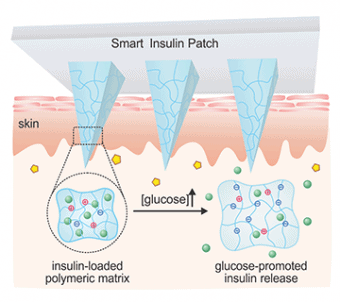Insulin Patch Could Provide Cheap, Simple, and Effective “Cure” for T1D
Low-tech, disposable drug delivery patch adjusts insulin dose based on current glucose levels without the need for expensive monitors or pumps
![Researchers were able to preload enough insulin into the coin-sized adhesive microneedle patches to enable clinical use. [Image courtesy of UCLA]](https://sp-ao.shortpixel.ai/client/q_glossy,ret_img,w_400/https://insulinnation.com/wp-content/uploads/2020/03/Compressed-Patch.jpeg)
When you picture the future of type 1 diabetes treatment, what comes to mind? For many, they see high tech devices capable of reading blood glucose levels and adjusting insulin and glucagon rates to keep sugars stable. Others see stem cell transplants and surgically implanted beta-cell devices.
What you are probably not picturing is a small, disposable, Nicorette-style patch full of insulin.
But this cheap little device, about the size of a quarter and meant to be discarded each morning, might be the key to a future free of diabetes management for millions of people around the world living with type 1.
What Is the Insulin Patch?
We had a chance to talk with Jingqiang Wang and Professor Zhen Gu of UCLA Engineering last June about their efforts to synthesize glucose-responsive insulin analogs.
In the intervening short period, they have come a long way in developing the first “insulin patch” that uses tiny microneedles to release insulin into the system based on current glucose levels.
Unlike most glucose-dependent systems we have today, notably the Medtronic hybrid-closed loop and the newer Tandem AID system, this little device does not require a lot of extra tech or the use of a CGM in order to automatically adjust insulin dose based on current glucose levels.
It is this simplicity that really makes this little device such a standout among the increasingly tech-heavy field of diabetes management. Not only would this patch simplify diabetes management for millions with T1D and for those with advanced type 2 diabetes, but it could do so at a fraction of the cost of what most patients spend on management tools today.

How Does Insulin Patch Work?
The patch is able to adjust insulin output based on current glucose levels in the body through the use of a glucose-sensing polymer that is enclosed with insulin. When glucose rates rise, microneedles in the patch open to allow insulin to diffuse into the subcutaneous area under the skin.
As glucose levels drop, the polymers close and reduce insulin flow into the body.
Not only does this automatic feedback allow for more stable blood sugars, but it does so without the need for blood sugar monitoring, carb counting, or manual insulin injection.
It may even be possible to combine this technology with the newly synthesized non-fibrillating glycoinsulin to greatly increase the patch’s effectiveness. Because this new type of insulin does not form inactive fibrils it is less likely to cause occultations within the tiny microneedles, thus keeping the insulin flow predictable and avoiding site rotation issues.
The goal is to design a patch that can be worn for 24 hours and then replaced each morning.
Because these materials are relatively inexpensive to manufacture compared to insulin pumps, CGM sensors, and other current diabetes management tech, the patch could significantly reduce the financial burden of managing diabetes.
And, if the patch works as well as the researchers at UCLA hope it will, it may significantly reduce how much time and effort a person with diabetes will have to put into keeping their sugars within a healthy range.
When Will the Insulin Patch Be Available?
The researchers behind the insulin patch recently concluded animal studies in mice and pig populations with impressive results. The patch was able to keep blood sugars stable in type 1 mice and pig models for over 20 hours at a time.
Currently, Zhen Gu and his associates are in the process of applying for FDA approval to begin human clinical trials. Once approved, human trials would allow researchers the opportunity to formulate patches specifically for use in people with T1D and advanced T2D.
Ideally, this cheap, disposable device could normalize blood sugar levels without the need for additional insulin injections or even finger sticks.
There is also a possibility that this tech could be adapted for other medical conditions requiring medication infusion based on physiological parameters.
While the insulin patch is likely still a few years off from being available to the general public, it is exciting to see this device entering the next phase of scientific study. If successful, it could completely change the vision for diabetes management and what an eventual cure may look like.
In the more immediate future, the insulin patch promises a simple and affordable method for controlling blood sugar for so many living with T1D, including millions worldwide who cannot afford the current, more advanced methods that many of us enjoy today.